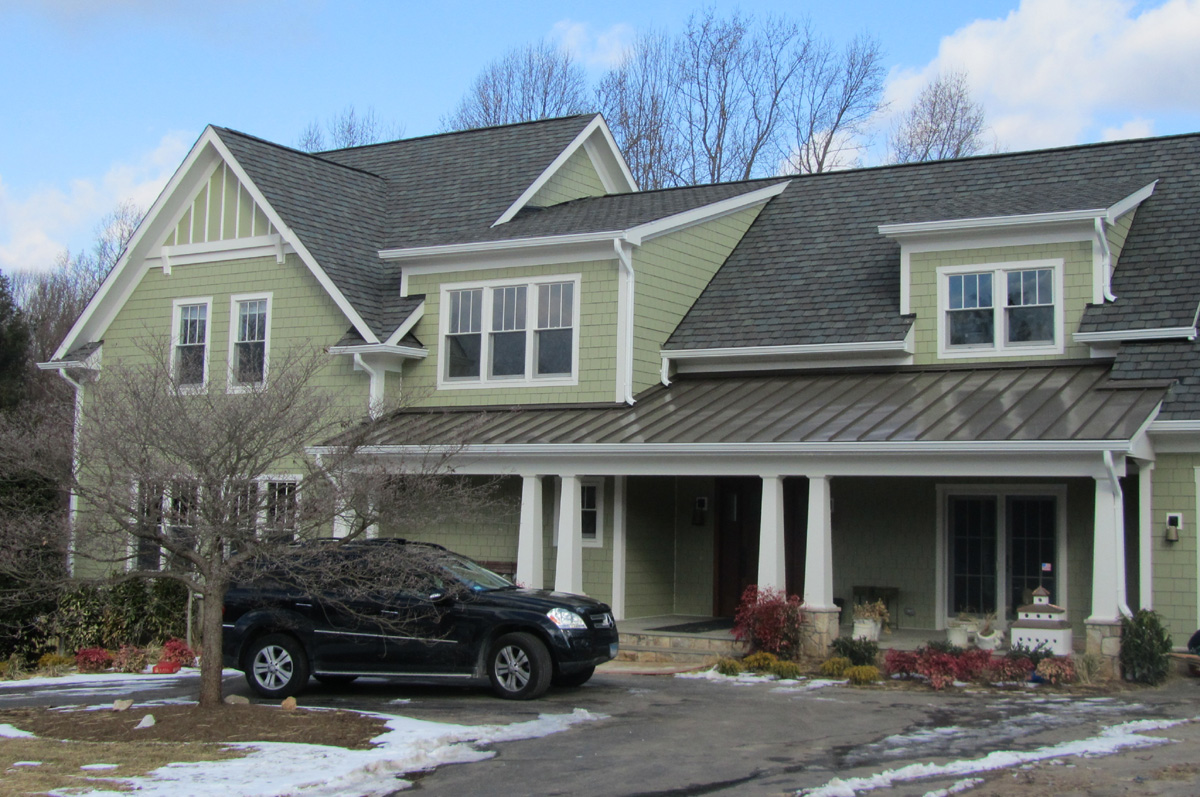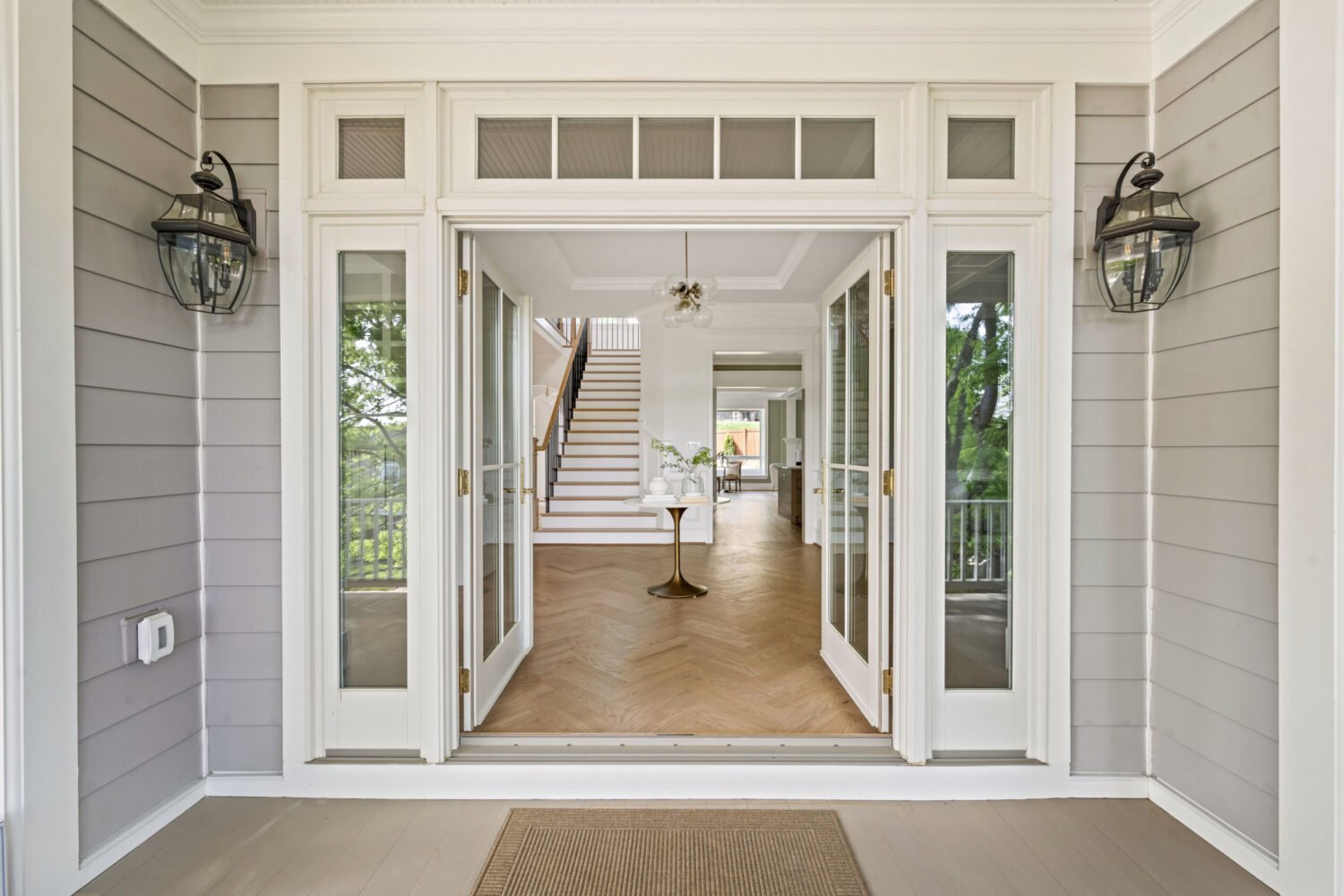Walk into the Ascent and you’ll find all the spiffy features you could ask for in a 21st-century apartment tower. There’s a pet-grooming salon and a bicycle-repair station, as well as a wi-fi-enabled lobby where you can check the flat-screen TV for potential delays at the Metro stop a three-minute walk away. The 24-hour concierge will sign for your grocery deliveries and store them in the walk-in fridge.
Every apartment has dark hardwood floors and floor-to-ceiling windows. On the 26th floor, you can lift weights in the fitness center, shoot billiards in the lounge, or relax on the roof deck. There’s a fire pit to huddle around in the winter, a swimming pool for summer, and an earth-friendly feature that won’t leave you feeling guilty about your carbon footprint: A rain garden prevents the first inch of precipitation from polluting nearby streams. Plus, because the apartment building is the tallest for miles, panoramic views stretch from Washington National Cathedral to the Blue Ridge Mountains.
Ready to move in? There’s one more thing you need to know: The Ascent is in Tysons Corner, a 4.3-square-mile tangle of parking lots and office parks that’s long been considered one of the least habitable parts of Washington. Until—maybe—now. “This is the difference between what’s been done in Tysons,” says developer Aaron Georgelas, “and what will be done in Tysons.”
He should know. His grandfather built homes in Fairfax County in the 1960s, and his father constructed high-rise offices in Tysons Corner in the 1980s. Now Georgelas is helping realize the next major phase of the area’s evolution. When he submitted designs in 2009 to turn 28 acres of commercial towers and industrial parks into a bustling urban center of restaurants, shops, and apartments, including what’s now the Ascent, he became a pioneer in what may be the most ambitious suburban redevelopment project not just in Washington but in all of American history.
Thanks to shopping malls and federal contracting dollars, Tysons Corner exploded from an empty cow field in the 1960s to America’s 12th-largest employment center in 2008. Along the way, it attracted Fortune 500 companies and some 120,000 total employees, becoming a textbook example of what’s known as an “edge city,” a concentration of business activity outside of a traditional downtown. But all this growth created so much congestion that by the early 2000s, it became clear Tysons wouldn’t survive if it didn’t transform itself from a car-clogged commuter drop zone into a vibrant, livable city.
County officials launched a sweeping initiative and drafted an urbanization plan defined by walkable city centers, seamlessly integrated public transportation, and acres of parkland. Politicians rewrote land-use rules, developers invested billions of dollars, and residents shouldered new taxes in an all-or-nothing bet that the transformation would convince people—by the tens of thousands—to move to an area best known for having more than 160,000 parking spaces. By 2050, proponents of the effort are banking on a population surge from 19,600 people today to as many as 100,000.
While other suburbs have undergone similar retrofittings, none has attempted anything on this scale; Tysons is almost as big as College Park. Already, urban planners from China and Russia have arrived to see the project for themselves.
“The redevelopment of Tysons is the most important urban redevelopment in the country, possibly in the world,” says Christopher Leinberger, a professor at George Washington University and a senior fellow in the Brookings Institution’s Metropolitan Policy Program. “If they do this right, it’ll be the model. Just as it was the model of edge cities, it will be the model of the urbanization of the suburbs. It’s that big.”
The making, unmaking, and remaking of Tysons Corner is about much more than a single suburb. It’s also the story of how modern Washington itself came into being as a region, and it offers a unique window into where it’s going, too.
• • •
The Tysons of today was founded by a man who would become one of Washington’s most influential real-estate developers, Ted Lerner. One day in the early 1960s, Lerner drove his wife, Annette, to the site of his next big conquest. The two had met at a GW fraternity dance in the 1940s, and it was her $250 loan he’d used to launch his Rockville firm, Lerner Enterprises. Today it’s one of the area’s largest private real-estate developers. But back then, Lerner was still getting started. He’d recently built Wheaton Plaza, a smart bet on America’s budding infatuation with shopping malls. Now he was thinking about wagering on Fairfax County, a fast-growing area with no major shopping centers to speak of. First he needed his wife’s opinion.
Annette wasn’t so sure. Looking around the area where Lerner wanted to build, she saw nothing but farmland: cows, a tractor, a log-cabin grocery store. Who on earth would come to a shopping mall out here? “You know, you’ve done rather well up till now,” she told her husband, according to Lerner. “But you’re going to blow it with Tysons Corner.”
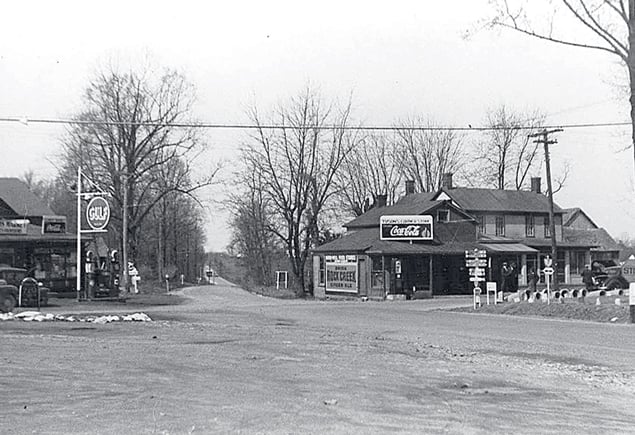
The site looked much as it had in the mid-1800s, when William Tyson owned a modest farm at the corner of two sleepy roads, now Route 7 and Route 123. Farmers like Tyson used Route 7 (also known as Leesburg Pike) to transport wheat, hogs, and dairy products to the markets in Alexandria. They took Route 123 (Chain Bridge Road) into Georgetown. Although neighboring parts of Montgomery County had filled out with tree-lined subdivisions and two-car garages, Tysons Corner remained a backwater into the early ’60s. Children walked barefoot around its gravel pits and dairy farms. Residents used back-yard latrines.
But all that was about to change, and Lerner knew it. Washington had begun building the Capital Beltway to ease traffic jams and facilitate the mobilization of the military in the event of a Cold War attack. The highway would be 64 miles long and encircle the city at a roughly ten-mile radius from the White House—planners wanted the Beltway far enough out so the capital wouldn’t be destroyed if, God forbid, Soviet missiles targeted the capital. And this radius, it turned out, was going to arc less than a mile east of the interchange at routes 7 and 123—Tysons Corner. Lerner understood the implication: The Beltway’s completion would put that undeveloped farmland smack in the middle of a three-road triangle accessible to every car owner in the area.
At the same time, Tysons was about to become a hub for a whole new industry—defense contracting. After World War II, the Defense Department had begun hiring private companies to research how the military could use its weapons more effectively. Tysons was an ideal locale for these firms because the Pentagon, built in 1943, was 13 miles down the road in one direction, and the new airport at Dulles, which opened in 1962, was 14 miles in the other.
The first research companies arrived in the mid-’60s; other types of defense contractors soon followed. Fifteen years later came the Reagan Revolution and the conservative crusade to shrink government. That led to the wide-scale outsourcing of work previously handled by federal employees. From 1980 to 2000, according to George Mason University, Uncle Sam’s spending on Washington-area contractors ballooned more than six-fold, to $29 billion a year. It was upon this pile of cash that Tysons Corner as we know it was born.
By the late 1980s, Tysons was the fastest-growing white-collar job market in North America and Europe for four straight years, according to Edge City, a cultural history of US suburbs written by Joel Garreau. Eager to embrace this surge in new workers, Fairfax County welcomed developers to pave over grasslands and throw up office towers. Cars by the tens of thousands filled employee parking lots, and just as Ted Lerner predicted, shoppers from all over the Beltway flocked to Tysons Corner Center, the mall his firm opened in 1968.
But in their frenzy for investment returns and new tax revenue, developers and politicians neglected to plan for anything resembling a community. Tysons had very few houses or apartment buildings, given its massive workforce, and its tiny residential population couldn’t support parks or restaurants, let alone schools. As a result, even as Tysons matured into an economic triumph, nobody actually wanted to live there.
The so-called edge city was a soul-sucking and chaotic jumble of used-car lots, strip malls, and office complexes. It had 167,000 parking spaces crammed into four square miles of land. And because the army of workers at Tysons operated on identical commuting clocks, its rush-hour traffic was among the region’s most horrific. By the beginning of the 21st century, Tysons had become a shrine to anonymous suburban sprawl. Or, as Clark Tyler puts it, “the blob that ate Northern Virginia.”
• • •
It was Tyler’s job to help shape the blob into a full-fledged city. In 2006, Virginia congressman Gerry Connolly, who was then chairing the Fairfax County Board of Supervisors, tapped Tyler to head the committee to transform Tysons. A retired consultant with Leidos, a defense contractor in Reston, Tyler had zero experience in urban planning or real-estate development. But after living in the county for almost a half century, he understood that something radical needed to be done. Tysons would “kill you if it keeps going the way it is,” he says.
Besides traffic, the list of other intractable problems was long. Because half the land was covered by parking lots and other impervious surfaces, untreated stormwater was leaching into nearby streams and carrying sludge to the Potomac River. Meanwhile, businesses were starting to flee for downtown DC—a shift in demand that threatened the very foundation of Tysons’s existence. On the flip side, Metro was going to build its 23-mile Silver Line to Dulles Airport and put four of the new stops right in the middle of Tysons. This meant that Tyler and his colleagues had a once-in-a-lifetime opportunity to reimagine its map—to redraw it, and, in effect, create a whole new city.
The 36-member task force was composed of all kinds of traditional adversaries with competing desires. Landowners and developers wanted to build larger structures than the county’s zoning ordinances allowed. Environmentalists wanted greener buildings. Homeowners wanted less traffic. Office workers wanted coffee shops and fitness centers, teachers and firefighters wanted homes they could afford, and residents wanted parks, gridded streets—neighborhoods. Some critics opposed any development at all.
Tyler’s job was to get them to work together, an undertaking of overwhelming magnitude, he says. But the group didn’t have to travel far to see what a redeveloped Tysons might look like. Right next door was Arlington County, a national model of dense, transit-oriented development known as “smart growth.”
After World War II, Arlington was a classic midcentury suburb, a place whose residents were so dependent on cars that the shopping mall was named Parkington Shopping Center. (It’s now Ballston Common Mall.) In the early ’60s, however, Arlington’s population growth slowed as new federal highways made more distant suburbs increasingly popular. Officials decided to launch a revitalization effort to attract new businesses and residents.
While Metro had originally proposed to run the Orange Line above ground along the median of I-66, Arlington successfully lobbied to have the trains routed underground and through the county’s key commercial districts, from Rosslyn to Ballston. Next, officials adopted a “bull’s-eye” strategy of concentrating larger buildings around Metro stations and tapering down density as development moved out toward neighborhoods of single-family homes. In the buildings near Metro stops, Arlington County pushed developers to accommodate a mix of uses—a restaurant or store on the ground floor, condos upstairs, office space next door—in order to give each neighborhood the feel of a city center. Parks, bike paths, and pedestrian-friendly streetscapes were prioritized.
The holistic approach worked because Arlington had leverage over developers. “We used our zoning tool,” says Bob Duffy, the county’s planning director. Bureaucrats couldn’t force the private sector to construct the skyline it wanted. But if a developer agreed to build in accordance with Arlington’s urban, mixed-use vision, the county would lift its density caps and allow a larger or taller structure than regulations typically permitted. Bigger buildings, of course, mean greater profits; the developers bit.
The urban villages that proceeded to sprout up around the Clarendon, Court House, and Ballston Metro stops became magnets for an emerging generation of residents: commuters fed up with Washington traffic, car-spurning millennials, empty-nesters downsizing from cul-de-sac homes to condos. By 2014, the county’s population had jumped 50 percent from 1980, to 229,302. Property values surged, and new businesses opened.
Today, Arlington has more office space than downtown Dallas, as well as the country’s highest concentration of 24-to-34-year-olds. Despite all this growth, the county’s figures show that traffic has actually declined—by as much as 23 percent on some key thoroughfares—because 40 percent of those living in Arlington’s urban corridors take public transportation to work.
Clark Tyler was impressed. And despite their competing interests, so were the other Tysons task-force members. “It was an eye-opener for them,” Tyler says. “They could see that those kinds of principles could control growth.” In 2008, after 3½ years of work and more than 300 meetings, the group agreed to a 40-year development plan guided by many of the same concepts that proved so successful in Arlington.
To spur a massive increase in housing, Fairfax County is allowing developers to put up taller buildings in Tysons, if they agree to deliver on a few things for the community. That might mean building to strict environmental standards, such as planting a rooftop garden to prevent runoff. Or setting aside a certain number of units at reduced prices for working-class residents. It could mean laying the groundwork for surrounding neighborhoods by installing grids of streets and sidewalks, building parks and bike paths, and someday—when the Tysons population hits specific thresholds—constructing schools, fire stations, and other public facilities.
While none of those are hard-and-fast requirements, builders who aren’t willing to provide enough enhancements to the neighborhood are unlikely to receive permission to bust through the density caps. This arrangement hands the bulk of the project’s multibillion-dollar infrastructure costs to developers. But residents and businesses will also have to chip in for transportation costs through additional real-estate taxes, which are expected to bring in about $250 million over the next 40 years.
It’s a blueprint of staggering ambition. Planners expect eight distinct neighborhoods, each with its own identity. They see 160 acres of parks and open spaces, venues for arts and culture, a restaurant-and-nightclub scene. And because 75 percent of new development is set to take place within walking distance of public transit (either Metro or internal “circulator” buses in the works), Tysons could even be carbon-neutral by 2030. All this as its workforce potentially doubles in size and its population increases up to five-fold. By 2050, there will be as many as 100,000 people living in Tysons. That is, if the forecasts bear out.
• • •
Walking through Tysons Corner today, you can see the outlines of this new city starting to fill in—cranes carrying metal beams to the tops of half-finished buildings, men in hardhats everywhere. Developers have broken ground on 12 projects so far. Capital One’s new 470-foot-high headquarters will be the region’s second-tallest structure, trailing only the Washington Monument, when it’s completed in 2018. Local developer Cityline Partners plans to restore portions of Scott’s Run—a trickling stream ruined over the years by erosion—and make it the centerpiece of a 40-acre community of high-rises and urban plazas.
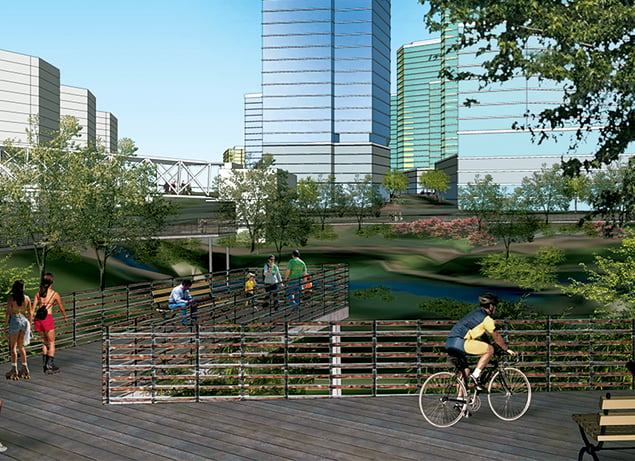
With each new project comes a fresh slug of enthusiasm. But the Ascent was the first building of tomorrow’s Tysons to be completed, and not everything has gone according to plan. Rising 26 stories, the tower is a soaring island unto itself, incongruously stranded in the morass of sprawl it was supposed to correct. The high-rise stands alongside a McDonald’s, an Exxon gas station, and the Container Store. Through their floor-to-ceiling windows, residents can watch traffic jams on Leesburg Pike and shoppers marching into Best Buy.
The Ascent was designed and built by Greystar, the nation’s largest apartment manager. (It bought the land from Aaron Georgelas’s company several years ago.) Headquartered in South Carolina, Greystar liked the prospect of getting in on a bullish market with such a significant “housing gap,” says Brandon Henry, a managing director of the firm.
But there’s no denying it’s been a rocky start. The area is so bereft of energy that Henry didn’t see the point in leasing the first-floor space in the Ascent to stores, as smart-growth design mandates. Instead, Greystar took advantage of flexible zoning regulations that county officials provided for the early redevelopment phase of Tysons and used the room for additional apartments.
Most troubling has been the weakness in apartment demand. Henry says that although the Ascent is meeting its goals—the building opened last April and has 60 percent of its 404 units rented—Greystar reduced rents at one point and has had to offer concessions to get leases signed. A 775-square-foot apartment with one bedroom and one bath is going for about $2,425 a month, and the Ascent is throwing in up to three months of free rent on certain units. Henry blames the glut of supply in Washington’s rental market. “There’s no real sense of urgency to make a decision,” he says.
The sluggish debut makes you wonder: When the Tysons task force came up with such an ambitious development plan, what exactly was it figuring would fuel the explosive growth the plan depended on? Their predictions were underpinned by two fundamental assumptions. First, that the Washington area’s economic engine would remain vigorous well into the future, creating nearly 75 percent more jobs—about 2.4 million—by 2050. And second, that Tysons would attract an outsize portion of these jobs.
Washington’s economy has always benefited from its special relationship with Uncle Sam. While national unemployment spiked during the recession, federal spending kept our local economy alive. The relative strength of the job market brought young, well-educated workers to the area and helped Washington shake off the economic slowdown long before other major cities.
But around 2010—just as politicians approved the blueprint for the new Tysons—things started to change. Budget pressure put the government-contracting industry in decline; federal procurement spending in the region dropped by 16 percent from 2010 to 2013. Average wages fell for three straight years. And during 2011 and 2012, Washington’s job growth ranked second to last among the nation’s 15 largest cities, behind even Detroit’s.
The deceleration has had a chilling effect on Tysons. Office vacancy rates nearly doubled, to 20 percent, in the fourth quarter of last year, from about 10 percent in 2007, according to the commercial real estate firm Cushman & Wakefield. Add that to the region-wide oversupply of rental housing and there’s reason to ask if there’ll ever be enough demand for all the new construction in Tysons.
George Mason University professor Stephen Fuller is the resident scholar of the regional economy, the economist who supplied the Tysons task force with its growth forecasts. He expects the area to rebound as local companies expand into new industries and the region becomes less dependent on the federal government and emerges as a standalone center for global business. That’s already beginning to happen in Tysons. It’s no longer just a hub of defense; today it’s home to a mix of Fortune 500 companies, including mortgage-finance giant Freddie Mac, hotelier Hilton Worldwide, and the financial-services company Capital One. Meanwhile, firms that once specialized in contracting have moved into emerging private-sector businesses like cybersecurity and health-care information technology.
“They’re planning for a different type of an economy,” Fuller says. “Not a government economy but a gold-plated economy, with business transactions nationally and globally.”
Gerald Gordon, CEO of the Fairfax County Economic Development Authority, singles out another reason for optimism about Tysons: “The Silver Line is the change agent.” Metro, Gordon says, will make the area more accessible to workers than it is now, and therefore more attractive to employers.
Some new businesses have already moved in. Last year, the event-planning software maker Cvent left McLean for an office by a Metro stop in Tysons, where it plans to add 400 new jobs. And the satellite-communications company Intelsat moved its headquarters from the District to a new 22-story office tower in Tysons, just a couple of steps from a Metro platform. “We were not going to move here if we didn’t have mass transit for our employees,” CEO David McGlade told the Washington Post.
• • •
It’ll take more than just transplanting jobs from one Washington community to another for the region as a whole not to suffer, however. And there are still other challenges, like luring new residents. Tysons, after all, needs a total image makeover.
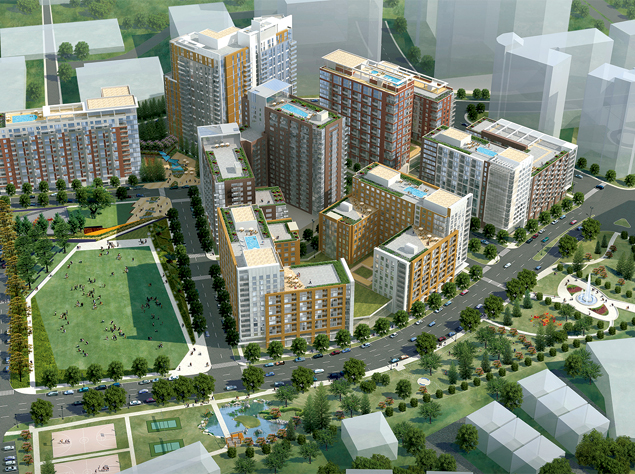
That job belongs to Michael Caplin. As president of the Tysons Partnership, a nonprofit association partly funded by developers and local businesses, the former prosecutor, public defender, Smithsonian program director, and arts producer has led the effort to rebrand Tysons as “America’s next great city.” He has arranged for a weekly farmers market on the parking lot of the National Automobile Dealers Association, created a Tour de Tysons bicycle race on a loop of streets near Tysons Galleria mall, and organized a live-music and food-truck festival one Saturday last September. “We’re changing perception as much as reality,” he says.
Developers are getting into it, too. Lerner Enterprises, for example, has allowed a vacant ten-acre grass lot to be used for community events (at least until it figures out what to build there). This summer, Lerner Town Square, as it’s being called, will host the 2015 World Police & Fire Games.
All this creativity aside, there’s one key handicap Tysons still must remedy: its utter unfriendliness to the very pedestrians who are so crucial to its growth plan. Take the crosswalk situation. According to Navid Roshan-Afshar, a civil engineer who runs a blog about the buildup of Tysons, you’re rarely more than 200 feet from a crosswalk in DC, but in Tysons, you’re often some 1,000 feet from one, meaning you have to walk six or eight minutes on a “superblock” to cross the street. What’s more, the crosswalks that do exist are death-defying. They span up to ten lanes of traffic and pit pedestrians against late-for-work commuters coming from every direction. Another problem: The walk signs “only last 20 seconds,” Roshan-Afshar says. “I’m an able-bodied 30-year-old person, and I have to sprint across the road.”
There’s also an issue with the Metro stations that stems from a fundamental mistake made early on in the overhaul. Instead of building the Silver Line underground, planners chose the less expensive option and put the rail line above ground. Smart-growth experts decried this decision, arguing that it would prevent the seamless integration of transit and development that Arlington achieved. Blocking the flow of pedestrian traffic effectively splits the corridors surrounding Metro stations—the beating hearts of walkable urban communities—into two separate neighborhoods. It is, as Caplin says, “a bit like having a river run through your city.”
Tysons redevelopment is far from perfect, and it may very well prove a historic flop. But for the politicians, developers, and bureaucrats who engineered it, there was no other choice. The days of the sizzling-hot office market—the vacancy rate in Tysons dipped to 1.7 percent in the late 1990s, Gordon says—are gone. And they’re not coming back. The era of the suburban office park is over. A multibillion-dollar wager on walkable city centers was the only chance Tysons had for long-term survival. Aboveground Metro or not.
Despite his bumpy start, Greystar’s Brandon Henry is certain that the Ascent—indeed, the entire redevelopment—will pan out over the long haul. After all, it took Arlington some 40 years to create its urban corridors, and Fairfax County has a similar timeline for Tysons. Henry is so confident of the project’s ultimate success that his firm has already purchased a second plot of land from Georgelas. He says it’ll be for another residential high-rise: “We broke ground in August.”
This article appears in our April 2015 issue of Washingtonian.

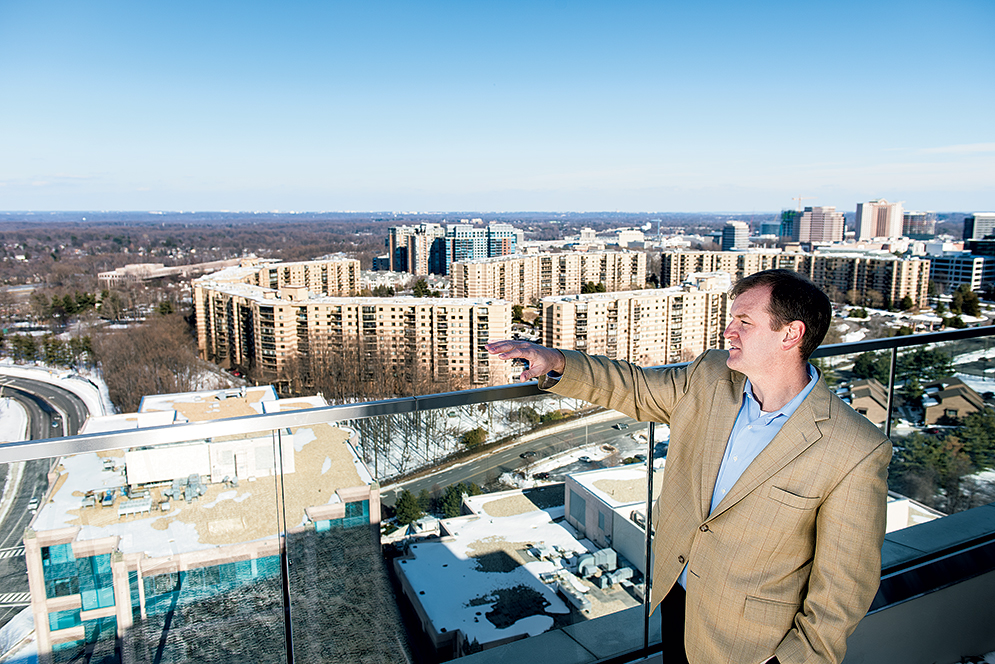
![Luke 008[2]-1 - Washingtonian](https://www.washingtonian.com/wp-content/uploads/2017/10/Luke-0082-1-e1509126354184.jpg)



